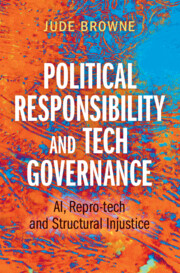14936 results
Religious Architecture and Roman Expansion
- Temples, Terracottas, and the Shaping of Identity, 3rd-1st c. BCE
- Coming soon
-
- Expected online publication date:
- December 2024
- Print publication:
- 31 December 2024
-
- Book
- Export citation
Modernism and the Idea of India
- The Art of Passive Resistance
- Coming soon
-
- Expected online publication date:
- November 2024
- Print publication:
- 30 November 2024
-
- Book
- Export citation

Political Responsibility and Tech Governance
- AI, Repro-tech and Structural Injustice
- Coming soon
-
- Expected online publication date:
- September 2024
- Print publication:
- 30 September 2024
-
- Book
- Export citation
Effect of vitamin D2 supplementation on 25-hydroxyvitamin D3 status: a systematic review and meta-analysis of randomised controlled trials
-
- Journal:
- Proceedings of the Nutrition Society / Volume 83 / Issue OCE2 / June 2024
- Published online by Cambridge University Press:
- 03 July 2024, E222
-
- Article
-
- You have access
- Export citation
The Crystal Structure of Talc
-
- Journal:
- Clays and Clay Minerals / Volume 21 / Issue 2 / April 1973
- Published online by Cambridge University Press:
- 01 July 2024, pp. 103-114
-
- Article
- Export citation
Micaceous Occlusions in Kaolinite Observed by Ultramicrotomy and High Resolution Electron Microscopy
-
- Journal:
- Clays and Clay Minerals / Volume 23 / Issue 2 / April 1975
- Published online by Cambridge University Press:
- 01 July 2024, pp. 125-129
-
- Article
- Export citation
Clay Mineralogy in Relation to Deltaic Sedimentation Patterns of Desmoinesian Cyclothems in Iowa-Missouri
-
- Journal:
- Clays and Clay Minerals / Volume 25 / Issue 3 / June 1977
- Published online by Cambridge University Press:
- 01 July 2024, pp. 171-186
-
- Article
- Export citation
Chlorite Examination by Ultramicrotomy and High Resolution Electron Microscopy
-
- Journal:
- Clays and Clay Minerals / Volume 21 / Issue 1 / February 1973
- Published online by Cambridge University Press:
- 01 July 2024, pp. 1-7
-
- Article
- Export citation
Artificial Alteration of Biotite Into a 14 Å Layer Silicate with Hydroxy-Aluminium Interlayers
-
- Journal:
- Clays and Clay Minerals / Volume 22 / Issue 3 / June 1974
- Published online by Cambridge University Press:
- 01 July 2024, pp. 241-252
-
- Article
- Export citation
Multiple-Ion Diffusion—I. Techniques for Measuring and Calculating Apparent Self-Diffusion Coefficients in Heteroionic Systems
-
- Journal:
- Clays and Clay Minerals / Volume 17 / Issue 5 / October 1969
- Published online by Cambridge University Press:
- 01 July 2024, pp. 271-277
-
- Article
- Export citation
Effect of Al3+ and H+ Upon the Simultaneous Diffusion of 85Sr and 86Rb in Kaolinite Clay
-
- Journal:
- Clays and Clay Minerals / Volume 16 / Issue 2 / July 1968
- Published online by Cambridge University Press:
- 01 July 2024, pp. 137-146
-
- Article
- Export citation
The Birefringent Orientation and Relaxation of Clay Platelets as Affected by Particle Size, Saturating Cation and Clay Type
-
- Journal:
- Clays and Clay Minerals / Volume 24 / Issue 4 / August 1976
- Published online by Cambridge University Press:
- 01 July 2024, pp. 163-169
-
- Article
- Export citation
Chapter 5 - Legal Issues and Expertise in Forensic Psychiatry
-
-
- Book:
- Seminars in Forensic Psychiatry
- Print publication:
- 13 June 2024, pp 119-140
-
- Chapter
- Export citation
Nurturing families: A feasibility randomised controlled trial of a whole-family intervention with vulnerable families in Jordan – ERRATUM
-
- Journal:
- Cambridge Prisms: Global Mental Health / Volume 11 / 2024
- Published online by Cambridge University Press:
- 04 June 2024, e69
-
- Article
-
- You have access
- Open access
- HTML
- Export citation
1 - The Derek Brewer Essay Prize: Playing Arthur: Making the Elizabethan Mariner
-
-
- Book:
- Arthurian Literature
- Published by:
- Boydell & Brewer
- Published online:
- 08 May 2024
- Print publication:
- 04 June 2024, pp 1-19
-
- Chapter
- Export citation
Chapter 4 - Socrates and Coherent Desire (Gorgias 466a–468e)
-
-
- Book:
- Plato's Gorgias
- Published online:
- 25 May 2024
- Print publication:
- 30 May 2024, pp 68-86
-
- Chapter
- Export citation
“Attentive, Intelligent, Rational, and Responsible”: Transforming Economics to Save the Planet, John Raymaker and Pierre Whalon. Milwaukee: Marquette University Press, 2023. (xxvii)+234pp. Pbk.$29.00
-
- Journal:
- Journal of Anglican Studies , First View
- Published online by Cambridge University Press:
- 27 May 2024, pp. 1-4
-
- Article
- Export citation
Praxis, Persistence, and Public Archaeology: Disrupting the Mission Myth at La Purísima Concepción
-
- Journal:
- American Antiquity , First View
- Published online by Cambridge University Press:
- 27 May 2024, pp. 1-18
-
- Article
- Export citation
P.024 Sex and gender reporting in clinical trials among neurological US Food and Drug Administration approvals
-
- Journal:
- Canadian Journal of Neurological Sciences / Volume 51 / Issue s1 / June 2024
- Published online by Cambridge University Press:
- 24 May 2024, p. S21
-
- Article
-
- You have access
- Export citation



